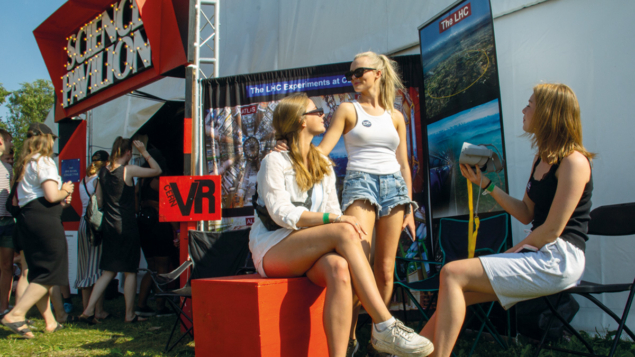Connie Potter describes the growing impact of the CERN Festival Programme, which brings cutting-edge physics to untapped audiences worldwide in a relaxed and informal setting.

Summer means holidays, beaches, long evenings outside and, for many, attending an outdoor festival. Music festivals in particular have expanded all over the world, and the competition to offer new experiences to curious festival goers has created opportunities to share CERN’s work and science with this untapped audience, many of whom never normally go to science events. Based on the success of CERN’s first Science Pavilion at Peter Gabriel’s world music festival WOMAD in 2016, the project has grown to become a highly successful outreach effort known as the CERN Festival Programme. The generally three-day programme offers a variety of shows, presentations, talks and hands-on workshops tailored to each country and demographic. The Pavilions are a real collaboration, a partnership between CERN, collaborating institutes in each country and the festival itself, each sharing costs and person power.
In 2019, four Science Pavilions were held in four different music and culture festivals in four different countries: the Big Bang Stage at the Ostrava festival in the Czech Republic, produced in partnership with Charles University and the Czech Technical University; the Magical Science Pavilion at the Pohoda Festival in Slovakia – an incredible space produced with Comenius University; the World of Physics at WOMAD in the UK, going strong year after year thanks to an enduring collaboration with Roger Jones of Lancaster University; and the Science Pavilion at the Roskilde Festival in Denmark, a highly successful relationship with Jørgen Beck Hansen at the Niels Bohr Institute in Copenhagen. More than 20,000 people came to the four spaces in 2019!
Workshops give people a chance to interact in a direct way with science and technology, as well as with physicists working on different experiments at CERN. They often can’t believe that these people who work for CERN have actually come to the festival to talk to them. A variety of topics are covered ranging from what’s new in physics to technological and scientific advances in the news that touch on people’s everyday lives, such as artificial intelligence. For 2023 we introduced a successful “scientific speed dating” with the young audience at Roskilde. A talk from CERN’s director for accelerators and technology Mike Lamont on physics and medicine and an informal “Chat with the AI experts” in the sunshine also proved incredibly popular at WOMAD this year. Between 4000 and 6000 people come to each Science Pavilion in each festival every year. Requests for new collaborations in other countries are coming in, and as a result there are currently ongoing discussions for Pavilions at festivals in the Netherlands and Spain. Physicists love the idea and their students are always an important asset to the event, with the most forward-thinking institutes keen to be part of the programme.
The feedback from visitors is clear: people love finding science at a music festival. The fact that the science is taken to them, where they are at their most comfortable, relaxed and receptive to new things, is key to the programme’s success. Comments range from “It’s a welcome break to sit in a cool space and learn something interesting and talk about stuff other than drinking and partying” to “I never liked science at school, I found it so boring and complicated, but here you make it fun and I’ve come back every year, I love it!”.
Recently, the Festival Programme was approved to be part of the CERN and Society Foundation. This means that an individual wishing to support this fantastic form of outreach and communication, or a company that understands the benefit of the programme and would like to have their logo at the festival next to ours, can now do so. It’s a great opportunity to reach new audiences, and especially to engage in those countries whose people are actually funding CERN.
Further reading
cernandsocietyfoundation.cern/projects/cern-festival-programme.







